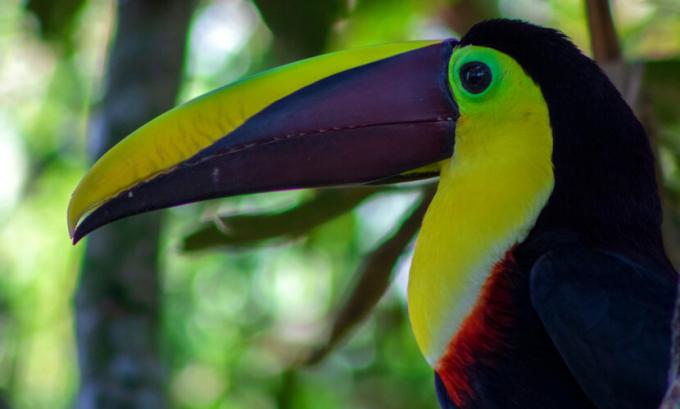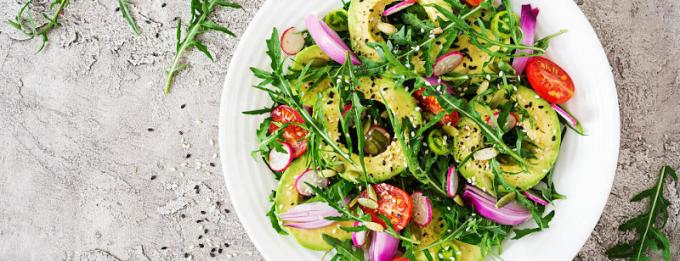toucans are birds well known to Brazilians, and can be observed in various parts of the national territory. unlike others birds, like macaws, what draws most attention about them are not the feathers but the large beak with vibrant color. These animals feed mainly on fruits, but they can also ingest eggs and chicks of other birds.
Read too: Hyacinth macaw — species of bird of the parrot family, same as parrots and parakeets
Toucans summary
They are birds belonging to the order Piciformes and family ramphastidae.
They are restricted to the neotropical region.
They have a large and vibrantly colored beak.
They have great ecological importance, acting in the dispersion of seedare you.
They feed on a wide variety of fruits, but they can also eat insects, eggs and baby birds of other species.
Toucan family
Toucans are related to saripoca and araçaris. All these animals are part of the order Piciformesand family ramphastidae. This family has 34 species, inserted into six genres. All these birds are found in the neotropical region, occupying areas from Mexico to Argentina. the birds of the family
ramphastideand they are usually seen in areas of tropical forests, forest patches and mountain forests. The Amazon region stands out for presenting a great diversity of species in this family.The family ramphastideand it has representatives with showy plumage, especially in the papo region, however, its characteristic is the presence of big and colorful beak on its representatives. When we observe the animal, we have the feeling that its beak is heavy, however, despite its size, it is quite light.
O nozzle shape is directly related to feeding of these birds. It allows these animals to be able to collect fruits in areas that are difficult to reach for others. birds and also helps in the capture of offspring of other species and eggs located in the interior of trees.
The birds of this family have uropigian gland(which releases an oily secretion used to waterproof the feather) split and your feet are zygodactyls (They have two fingers facing forward and two fingers facing backwards). These birds also have a unique arrangement of caudal vertebrae, which allows them to projectandm its tail forward to sleep. They have daytime habits, sleeping and resting at night, inside hollows or on tree branches. They live in a pack.
the birds of the family ramphastideand they usually lay their eggs in hollows or crevices in trees and ravines. Puppies are born with their eyes closed and without feathers after an incubation period that lasts approximately 18 days. Male and female take care of the young after birth.
Although they also feed on eggs and baby birds, the family ramphastideand stands out for consuming a wide variety of fruits. By consuming them, these birds promote the seed dispersal, taking them away from the plant from which they were taken. As such, they are of great ecological importance.
Video lesson on birds
Toucan characteristics
Toucans have between 46 cm and 66 cm long and large beak, laterally flattened, with serrated edge and very colorful. The beak is so long that the toucans are among the birds withyou larger beaks in relation to body size. In addition to acting in the capture of food, the beak is related to reproduction, as it works as a sexual ornament, and is a sounding board.
In addition to these functions, and due to the fact that it is highly vascularized, the toucan's beak is an important region for heat exchange. It regulates heat distribution by modifying blood flow from the body to the beak and vice versa. Most toucans do not differ between males and females in terms of plumage, the difference is in the length and shape of the beak.
Read too:Why do birds sing?
Toucans feeding
Toucans feed mainly on fruits, but they can also ingest insects, baby birds and even eggs. For this, they have an elongated beak, which allows them to access places that not all animals have access to. Due to the fact that they ingest vegetables as well as animals, we can conclude that they they are omnivores.
Toucan species
When we talk about toucans, many people only remember the toco toucan, a species that stands out for its large vibrant orange beak, however, there are different species, with beaks with quite color patterns. differentiated. Next, we will get to know some species of toucans and their characteristics.

Toco Toucan
The Toco Toucan(Ramphastos touch), also known as toucanuçu, is a species that is about 56 cm long and has a body mass of 540 grams, standing out as the largest of all toucans. It has a wide, long beak, with a vibrant orange hue, a black spot on the tip and red streaks perpendicular to the main axis. On most of its body, black feathers are present. In the neck region, they are white. The bare skin around the eyes is orange or yellow, and the eyelids are turquoise blue.
Toco Toucan can be found at thick and in forests in the interior of Brazil. It differs from other species in that it occurs in semi-open areas. The toco toucan is generally seen living in flocks of approximately 20 individuals. During the reproductive period, however, they are seen in couples. This species is monogamous. They nest in tree hollows and use their beak to make the cavity the ideal size. Incubation lasts about 16 days, and the female lays two to four eggs. The toco toucan lives, on average, 40 years.
rainbow-billed toucan
The rainbow-billed toucan (Sulfurate Ramphastus) is a species that, as its popular name suggests, has a beak rich in color. In the beak of this bird the yellowish green color predominates, but we can still identify red, blue and orange spots. The region around the eyes is yellowish green or bluish green. Its chest is yellowish, which is why it is also called a yellow-breasted toucan. The throat and neck region also has a yellow coloration, however, most of its body has black plumage. Occurs in northern Colombia and Central America.
Choco Toucan

The choco toucan (Ramphastos brevis) is a species that occurs in Colombia and Ecuador. It has a striking yellow and black beak. Your eyelids and the area around your eyes are green or yellowish green. Throat and neck are yellowish, with a white band and a red band at the transition from throat to chest.



